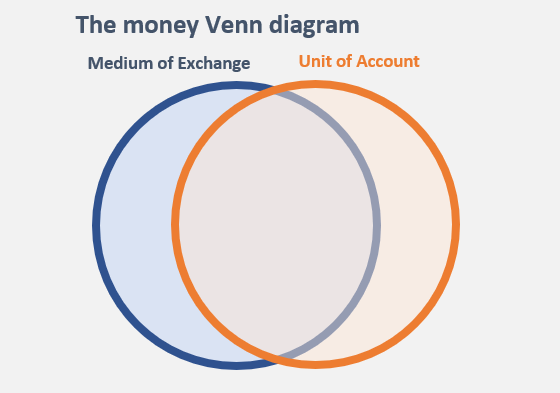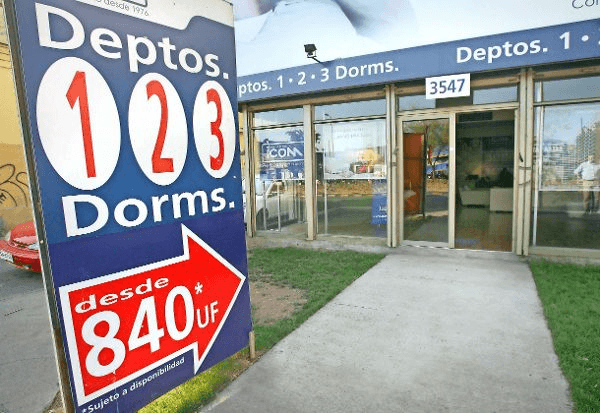A Simpler and More Accurate Way to Teach Money to Students

When we first learn about money and banking in high school or university, we are all taught that money has three functions: medium of exchange, unit of account, and store of value. Maybe it’s time for educators to throw out this triumvirate. It’s not very accurate.
We need a simple and teachable device to take the triumvirate’s place. I propose the money Venn diagram.

Before I explain the money Venn diagram, let’s revisit the textbook triumvirate.
When something is a medium of exchange, what is meant is that it is generally acceptable in trade. You can use it to buy stuff at the grocery store, or purchase stocks on the stock market, or get things online.
The quality of being a medium of exchange is really more of a gradient than a matter of either/or. Banknotes, for instance, are good at brick and mortar shops, but useless online. Your debit card works great at shops, but forget trying to buy shares with it. But both are sufficiently widely accepted to qualify as a medium of exchange.
Because cryptocurrencies like Bitcoin and Litecoin aren’t widely accepted, they don’t make it across the line to qualify as a medium of exchange. Neither do Walmart or Target gift cards. Cigarettes don’t qualify either, but that wasn’t the case in 1950 when Milton Friedman used them to buy gas:
The unit of account function of money refers to the fact that our economic conversations and calculations are couched in terms of a given monetary unit, whether that be the $, ¥, or £. In Canada and the US, prices are expressed in grocery aisles with dollars, our salaries use dollar units, and our debts are denominated in dollars. We don’t express prices in terms of government bonds, or Microsoft shares, or cigarettes or bitcoins. These things don’t function as a unit of account.
Thirdly, when money acts as a store of value we mean that it preserves value over time and space. Whereas the first two functions are quite useful, the store of value isn’t. Every asset functions as a store of value: houses, diamonds, banknotes, deposits, bitcoins, LSD tabs, lentils, cars, spices. And so it is meaningless to cast store of value as a unique function of money. Monetary economists such as Nick Rowe and George Selgin have proposed, and I concur, that we just chuck store of value from the definition of money.
But we are still left with two useful definitions for money, unit of account and medium of exchange. Which gets us to the money circle.
Note that the two circles in the diagram, medium of exchange and unit of account, don’t perfectly overlap. About 99% of the time the things we use as media of exchange are also the things we use as a unit of account. So the contents of our wallets or our bank accounts, dollar banknotes and dollar deposits are functionally equivalent to the $ units displayed in signs in grocery aisles.
But for the remaining 1% of the time, the unit of account and medium of exchange are separated. The idea of a separation is tough to get one’s head around. Luckily we’ve got a nice example. In Chile the prices of many things, particularly real estate, are expressed in terms of the Unidad de Fomento. But no Unidad de Fomento notes or coins circulate in Chile. It is a purely abstract unit of account.

If a Chilean wants to buy an apartment that is priced at 840 Unidad de Fomento, she must use a separate medium of exchange, the Chilean peso, to make the payment. The peso is issued by Chile’s central bank, the Banco Central de Chile, in both paper and account form.
How many pesos must she pay? Every day the Banco Central de Chile publishes the exchange rate between the Unidad de Fomento and the peso. Right now one Unidad de Fomento is equal to 28,969 pesos. If an apartment were priced at 840 Unidad de Fomento, a Chilean would have to hand over 24 million Chilean pesos today.
Why has Chile separated its unit of account from its medium of exchange? I have discussed the issue at length. But the short answer is that it was a trick the government used to help cope with high inflation in the 1960s. Chilean inflation has been well under control for decades now. The practice of using the Unidad de Fomento as a unit-of-account has continued nonetheless.
You can see why it’s rare for these two functions to be separated. It’s awkward to do conversions every time one wants to pay for something. For the sake of ease, we tend to evolve towards systems where the medium of exchange and unit of account are united. But these exceptions are still important enough that we need a Venn diagram.
To sum up, money isn’t best thought of as a medium of exchange, unit of account, and store of value. Let’s just think of it as just a medium of exchange and a unit of account. For the most part these circles overlap, and the two functions are united. But this isn’t always the case.











